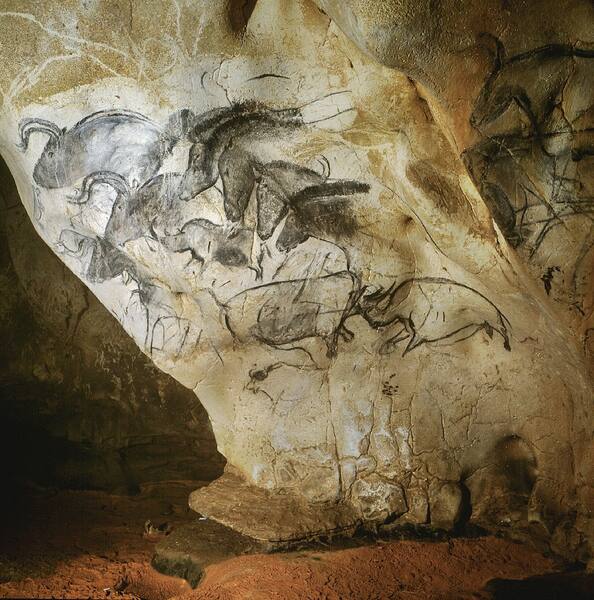Decorated Cave of Pont d’Arc, known as Grotte Chauvet-Pont d’Arc, Ardèche
Decorated Cave of Pont d’Arc, known as Grotte Chauvet-Pont d’Arc, Ardèche
Located in a limestone plateau of the Ardèche River in southern France, the property contains the earliest-known and best-preserved figurative drawings in the world, dating back as early as the Aurignacian period (30,000–32,000 BP), making it an exceptional testimony of prehistoric art. The cave was closed off by a rock fall approximately 20,000 years BP and remained sealed until its discovery in 1994, which helped to keep it in pristine condition. Over 1,000 images have so far been inventoried on its walls, combining a variety of anthropomorphic and animal motifs. Of exceptional aesthetic quality, they demonstrate a range of techniques including the skilful use of shading, combinations of paint and engraving, anatomical precision, three-dimensionality and movement. They include several dangerous animal species difficult to observe at that time, such as mammoth, bear, cave lion, rhino, bison and auroch, as well as 4,000 inventoried remains of prehistoric fauna and a variety of human footprints.
Description is available under license CC-BY-SA IGO 3.0
Grotte ornée du Pont-d’Arc, dite Grotte Chauvet-Pont-d’Arc, Ardèche
Située dans un plateau calcaire traversé par les méandres de la rivière Ardèche, au sud de la France, la grotte recèle les plus anciennes peintures connues à ce jour (période de l’aurignacien : entre 30 000 et 32 000 av. J.-C.). Cette grotte exceptionnelle qui témoigne de l’art préhistorique a été fermée par un éboulement il y a environ 20 000 ans BP et elle est restée scellée jusqu’à sa redécouverte en 1994, ce qui a permis de la conserver de façon exceptionnelle. Plus de 1 000 peintures, aux motifs anthropomorphes ou animaliers, ont été inventoriées sur ses murs. Leur qualité esthétique exceptionnelle témoigne d’une large gamme de techniques, notamment la maîtrise de l'estompe, la combinaison peinture-gravure, la précision anatomique, la représentation tridimensionnelle et du mouvement. On y trouve notamment des représentations d’espèces dangereuses, difficiles à observer pour les hommes de l’époque (mammouths, ours, lions des cavernes, rhinocéros, bisons, aurochs), plus de 4 000 restes de la faune du paléolithique et diverses empreintes de pas humains.
Description is available under license CC-BY-SA IGO 3.0
Gruta ornamentada de Pont d’Arc, denominada Gruta Chauvet-Pont d’Arc (Departamento del Ardèche, Francia)
En este sitio, situado al sur de Francia, en una meseta calcárea del río Ardèche, se hallan los dibujos figurativos más antiguos y mejor conservados del mundo. Realizados en el Periodo Auriñaciense (esto es, entre 30.000 y 32.000 años atrás), estos dibujos constituyen un testimonio excepcional del arte prehistórico. Hace unos 20.000 años, un desprendimiento de rocas cerró herméticamente la entrada de la gruta hasta su hallazgo en 1994, lo cual permitió que se conservara en su estado primigenio. Hasta la fecha se han podido catalogar más de 1.000 imágenes pintadas en sus paredes con una gran variedad de motivos animales y antropomórficos. Su calidad estética es excepcional y su ejecución pone de manifiesto el dominio de toda una serie de técnicas: pericia en el uso de los colores, combinación de la pintura y el grabado, precisión anatómica, tridimensionalidad y sentido del movimiento. Las imágenes muestran diversas especies animales peligrosas y difíciles de observar en esa época (mamuts, osos, gatos monteses, rinocerontes, bisontes y uros), y también se han hallado unos 4.000 restos catalogados de fauna prehistórica y un variado conjunto de huellas humanas.
source: UNESCO/CPE
Description is available under license CC-BY-SA IGO 3.0
アルデッシュ ショーヴェ・ポンダルク洞窟壁画
フランス南東部アルデッシュ県の石灰岩台地に位置する約8500㎡のショーヴェ洞窟では、3万年前以上から描かれた世界最古級の壁画が1000点以上も見られる。この洞窟は約2万年前の落石によって閉ざされていたため、1994年に発見された際にもきわめて良好な保存状態を保っていた。マンモスやクマ、ヤマネコ、サイ、バイソンなどが描かれた壁画は解剖学的にも精度が高く、有史以前の人類と動物の関わりや環境を知る手がかりとなると同時に、人類最古の天才的な絵画表現ならびに、その証拠として高い価値を持つ。source: NFUAJ
Beschilderde grot van Pont d'Arc (Grotte Chauvet-Pont d'Arc), Ardèche
De beschilderde grot van Pont d'Arc – bekend als Grotte Chauvet-Pont d'Arc – ligt in een kalkstenen plateau van de rivier de Ardèche in Zuid-Frankrijk. De grot bevat de vroegst bekende en best bewaarde figuratieve tekeningen ter wereld, daterend uit het Aurignacien (30.000 tot 32.000 voor Christus). Daarmee is het een bijzonder voorbeeld van prehistorische kunst. Ongeveer 20.000 jaar voor Christus werd de grot afgesloten door een vallende steen en bleef verzegeld tot de ontdekking ervan in 1994. Hierdoor bleef de grot in ongerepte staat. Tot nu toe zijn er op de muren meer dan 1000 afbeeldingen ontdekt die antropomorfe en dierlijke motieven met elkaar verbinden. Ze zijn van buitengewone esthetische kwaliteit en tonen diverse technieken waaronder kundig kleurgebruik, het combineren van verf en gravure, anatomische precisie, driedimensionaliteit en beweging. De grotschilderingen tonen verschillende gevaarlijke diersoorten die in die tijd moeilijk waar te nemen waren, zoals mammoeten, beren, wilde katten, neushoorns, bizons en oerossen. In de grot vond men ook 4000 overblijfselen van prehistorische fauna en diverse menselijke voetafdrukken.
Source: unesco.nl
